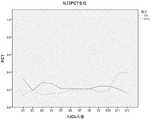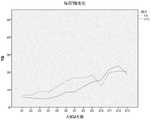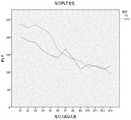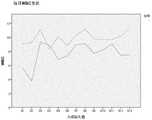CN114601840A - A pharmaceutical composition for treating pneumocystis carinii pneumonia - Google Patents
A pharmaceutical composition for treating pneumocystis carinii pneumoniaDownload PDFInfo
- Publication number
- CN114601840A CN114601840ACN202011444225.8ACN202011444225ACN114601840ACN 114601840 ACN114601840 ACN 114601840ACN 202011444225 ACN202011444225 ACN 202011444225ACN 114601840 ACN114601840 ACN 114601840A
- Authority
- CN
- China
- Prior art keywords
- sulfamethoxazole
- pneumocystis carinii
- clindamycin
- carinii pneumonia
- purposes
- Prior art date
- Legal status (The legal status is an assumption and is not a legal conclusion. Google has not performed a legal analysis and makes no representation as to the accuracy of the status listed.)
- Pending
Links
Images
Classifications
- A—HUMAN NECESSITIES
- A61—MEDICAL OR VETERINARY SCIENCE; HYGIENE
- A61K—PREPARATIONS FOR MEDICAL, DENTAL OR TOILETRY PURPOSES
- A61K31/00—Medicinal preparations containing organic active ingredients
- A61K31/63—Compounds containing para-N-benzenesulfonyl-N-groups, e.g. sulfanilamide, p-nitrobenzenesulfonyl hydrazide
- A61K31/635—Compounds containing para-N-benzenesulfonyl-N-groups, e.g. sulfanilamide, p-nitrobenzenesulfonyl hydrazide having a heterocyclic ring, e.g. sulfadiazine
- A—HUMAN NECESSITIES
- A61—MEDICAL OR VETERINARY SCIENCE; HYGIENE
- A61K—PREPARATIONS FOR MEDICAL, DENTAL OR TOILETRY PURPOSES
- A61K31/00—Medicinal preparations containing organic active ingredients
- A61K31/33—Heterocyclic compounds
- A61K31/395—Heterocyclic compounds having nitrogen as a ring hetero atom, e.g. guanethidine or rifamycins
- A61K31/495—Heterocyclic compounds having nitrogen as a ring hetero atom, e.g. guanethidine or rifamycins having six-membered rings with two or more nitrogen atoms as the only ring heteroatoms, e.g. piperazine or tetrazines
- A61K31/505—Pyrimidines; Hydrogenated pyrimidines, e.g. trimethoprim
- A—HUMAN NECESSITIES
- A61—MEDICAL OR VETERINARY SCIENCE; HYGIENE
- A61K—PREPARATIONS FOR MEDICAL, DENTAL OR TOILETRY PURPOSES
- A61K31/00—Medicinal preparations containing organic active ingredients
- A61K31/70—Carbohydrates; Sugars; Derivatives thereof
- A61K31/7042—Compounds having saccharide radicals and heterocyclic rings
- A61K31/7052—Compounds having saccharide radicals and heterocyclic rings having nitrogen as a ring hetero atom, e.g. nucleosides, nucleotides
- A61K31/7056—Compounds having saccharide radicals and heterocyclic rings having nitrogen as a ring hetero atom, e.g. nucleosides, nucleotides containing five-membered rings with nitrogen as a ring hetero atom
- A—HUMAN NECESSITIES
- A61—MEDICAL OR VETERINARY SCIENCE; HYGIENE
- A61P—SPECIFIC THERAPEUTIC ACTIVITY OF CHEMICAL COMPOUNDS OR MEDICINAL PREPARATIONS
- A61P11/00—Drugs for disorders of the respiratory system
- A—HUMAN NECESSITIES
- A61—MEDICAL OR VETERINARY SCIENCE; HYGIENE
- A61P—SPECIFIC THERAPEUTIC ACTIVITY OF CHEMICAL COMPOUNDS OR MEDICINAL PREPARATIONS
- A61P33/00—Antiparasitic agents
- A61P33/02—Antiprotozoals, e.g. for leishmaniasis, trichomoniasis, toxoplasmosis
- A61P33/08—Antiprotozoals, e.g. for leishmaniasis, trichomoniasis, toxoplasmosis for Pneumocystis carinii
Landscapes
- Health & Medical Sciences (AREA)
- Life Sciences & Earth Sciences (AREA)
- Veterinary Medicine (AREA)
- Pharmacology & Pharmacy (AREA)
- Medicinal Chemistry (AREA)
- Chemical & Material Sciences (AREA)
- Animal Behavior & Ethology (AREA)
- General Health & Medical Sciences (AREA)
- Public Health (AREA)
- Epidemiology (AREA)
- Chemical Kinetics & Catalysis (AREA)
- General Chemical & Material Sciences (AREA)
- Nuclear Medicine, Radiotherapy & Molecular Imaging (AREA)
- Organic Chemistry (AREA)
- Tropical Medicine & Parasitology (AREA)
- Molecular Biology (AREA)
- Engineering & Computer Science (AREA)
- Bioinformatics & Cheminformatics (AREA)
- Pulmonology (AREA)
- Pharmaceuticals Containing Other Organic And Inorganic Compounds (AREA)
Abstract
Translated fromChineseDescription
Translated fromChinese技术领域technical field
本发明属于制药领域,更具体地,本发明公开了一种联合用药,用于治疗卡氏肺孢子虫肺炎(Pneumocystis pneumonia,PCP)。The invention belongs to the field of pharmacy, and more particularly, the invention discloses a combined medicine for treating Pneumocystis pneumonia (PCP).
背景技术Background technique
卡氏肺孢子虫肺炎(Pneumocystis pneumonia,简称PCP,在本专利中用PCP代替)是HIV和非HIV相关免疫缺陷患者中常见的机会感染之一。尤其是实体器官移植患者,PCP的总发生率在5-15%之间。其影响因素包括术后预防措施、移植器官类型及免疫抑制方案等。PCP可导致患者出现干咳、高热、气促等症状,严重者可导致低氧血症、呼吸衰竭或ARDS。非HIV的PCP肺炎患者的症状及进展比HIV-PCP快,病情更为严重,通常以严重低氧血症为主。有研究提示非HIV感染患者的PCP的死亡率高达30%–60%。随着实体器官移植数量的与日俱增,如何能更有效的治疗实体器官移植术后重症PCP,便日益成为亟待解决的问题。Pneumocystis pneumonia (PCP for short, replaced by PCP in this patent) is one of the common opportunistic infections in HIV and non-HIV-related immunodeficiency patients. Especially in solid organ transplant patients, the overall incidence of PCP is between 5-15%. The influencing factors include postoperative preventive measures, types of transplanted organs, and immunosuppressive regimens. PCP can cause symptoms such as dry cough, high fever, shortness of breath, and in severe cases, hypoxemia, respiratory failure, or ARDS. The symptoms and progression of non-HIV PCP pneumonia patients are faster than HIV-PCP, and the disease is more severe, usually with severe hypoxemia. Studies have shown that the mortality rate of PCP in non-HIV-infected patients is as high as 30%–60%. With the increasing number of solid organ transplantation, how to more effectively treat severe PCP after solid organ transplantation has increasingly become an urgent problem to be solved.
目前,针对实体器官移植术后的PCP,一线治疗仍为复方磺胺甲噁唑,其标准剂量为15-20mg/公斤体重/天甲氧苄啶(TMP)和75-100mg/公斤体重/天磺胺甲恶唑(SMX)。但这是基于上世纪七八十年代的一些小型、非对照的观察性研究所得出的结论(Lau WK,YoungLS:Trimethoprim-sulfamethoxazole treatment of Pneumocystis carinii pneumoniain adults.N Engl J Med 1976,295(13):716-718,Winston DJ,Lau WK,Gale RP,YoungLS:Trimethoprim-sulfamethoxazole for the treatment of Pneumocystis cariniipneumonia.Ann Intern Med 1980,92(6):762-769)。因此,在缺乏随机对照研究的情况下,目前尚未确定复方磺胺甲噁唑治疗实体器官移植术后PCP的最佳剂量。此外,该标准剂量由于其药物剂量偏大,较易产生药物不良反应,导致临床使用时依从性较低,从而降低了疗效。为了减少复方磺胺甲噁唑的不良反应、增加药物使用的依从性,有研究使用中剂量(10mg/kg/d TMP)、降阶梯剂量或低剂量(4-10mg/公斤体重/天TMP)来治疗实体器官移植术后的PCP。但这些给药方案的治疗效果仍存在争议。另一方面,复方磺胺甲噁唑是通过作用于二氢叶酸合成酶和还原酶,双重阻断细菌叶酸合成的第一、第二步,从而干扰了细菌蛋白合成。而目前已有研究提示卡氏肺孢子虫存在二氢叶酸合成酶和还原酶的基因突变,尤其是使用复方磺胺甲噁唑预防PCP的患者中,这种突变更易发生,从而导致对于复方磺胺甲噁唑的耐药性产生。一般而言,当复方磺胺甲噁唑治疗PCP失败时,可采用阿托伐醌、氨苯砜及克林霉素-伯氨喹等作为二线替代方案。但是这些治疗方案的治疗效果尚无法达到复方磺胺甲噁唑的疗效(Kosaka M,Ushiki A,Ikuyama Y,Hirai K,Matsuo A,Hachiya T,HanaokaM:A Four-Center Retrospective Study of the Efficacy and Toxicity of Low-DoseTrimethoprim-Sulfamethoxazole for the Treatment of Pneumocystis Pneumonia inPatients without HIV Infection.Antimicrob Agents Chemother 2017,61(12).Schmidt JJ,Lueck C,Ziesing S,Stoll M,Haller H,Gottlieb J,Eder M,Welte T,Hoeper MM,Scherag A et al:Clinical course,treatment and outcome ofPneumocystis pneumonia in immunocompromised adults:a retrospective analysisover 17years.Crit Care 2018,22(1):307.)。At present, the first-line treatment for PCP after solid organ transplantation is still compound sulfamethoxazole, whose standard doses are 15-20 mg/kg body weight/day trimethoprim (TMP) and 75-100 mg/kg body weight/day sulfamethoxazole Methoxazole (SMX). But this is based on some small, uncontrolled observational studies in the 1970s and 1980s (Lau WK, Young LS: Trimethoprim-sulfamethoxazole treatment of Pneumocystis carinii pneumoniain adults. N Engl J Med 1976, 295(13) :716-718, Winston DJ, Lau WK, Gale RP, Young LS: Trimethoprim-sulfamethoxazole for the treatment of Pneumocystis cariniipneumonia. Ann Intern Med 1980, 92(6):762-769). Therefore, in the absence of randomized controlled studies, the optimal dose of compound sulfamethoxazole for the treatment of PCP after solid organ transplantation has not yet been determined. In addition, the standard dose is prone to adverse drug reactions due to its large drug dose, resulting in low compliance in clinical use, thereby reducing the efficacy. In order to reduce the adverse reactions of compound sulfamethoxazole and increase the compliance of drug use, some studies have used medium dose (10mg/kg/d TMP), de-escalated dose or low dose (4-10mg/kg body weight/day TMP) to Treatment of PCP after solid organ transplantation. However, the therapeutic efficacy of these dosing regimens remains controversial. On the other hand, compound sulfamethoxazole acts on dihydrofolate synthase and reductase to double block the first and second steps of bacterial folic acid synthesis, thereby interfering with bacterial protein synthesis. At present, studies have shown that Pneumocystis carinii has gene mutations of dihydrofolate synthase and reductase, especially in patients who use compound sulfamethoxazole to prevent PCP, this mutation is more likely to occur, which leads to the occurrence of compound sulfamethoxazole. resistance to oxazole. In general, when compound sulfamethoxazole fails to treat PCP, atovaquone, dapsone, and clindamycin-primaquine can be used as second-line alternatives. However, the therapeutic effects of these regimens are still not as effective as those of compound sulfamethoxazole (Kosaka M, Ushiki A, Ikuyama Y, Hirai K, Matsuo A, Hachiya T, Hanaoka M: A Four-Center Retrospective Study of the Efficacy and Toxicity of Low-DoseTrimethoprim-Sulfamethoxazole for the Treatment of Pneumocystis Pneumonia inPatients without HIV Infection. Antimicrob Agents Chemother 2017, 61(12). Schmidt JJ, Lueck C, Ziesing S, Stoll M, Haller H, Gottlieb J, Eder M, Welte T, Hoeper MM, Scherag A et al: Clinical course, treatment and outcome of Pneumocystis pneumonia in immunocompromised adults: a retrospective analysis over 17years. Crit Care 2018, 22(1):307.).
对于重症PCP而言,伯氨喹联合克林霉素被认为是最有效的二线治疗方案。但伯氨喹的毒性反应明显,包括急性胰腺炎、血糖波动、骨髓抑制、肾功能不全和电解质紊乱等(Nickel P,Schurmann M,Albrecht H,Schindler R,Budde K,Westhoff T,Millward J,Suttorp N,Reinke P,Schurmann D:Clindamycin-primaquine for pneumocystisjiroveci pneumonia in renal transplant patients.Infection 2014,42(6):981-989.Benfield T,Atzori C,Miller RF,Helweg-Larsen J:Second-line salvagetreatment of AIDS-associated Pneumocystis jirovecii pneumonia:a case seriesand systematic review.J Acquir Immune Defic Syndr 2008,48(1):63-67.)。因此,能找到一个既能保持或提高复方磺胺甲噁唑疗效,又能通过减少复方磺胺甲噁唑剂量来降低不良反应,是摆在面前急需解决的临床问题。For severe PCP, primaquine combined with clindamycin is considered to be the most effective second-line therapy. However, the toxicity of primaquine is obvious, including acute pancreatitis, blood sugar fluctuation, myelosuppression, renal insufficiency and electrolyte disturbance (Nickel P, Schurmann M, Albrecht H, Schindler R, Budde K, Westhoff T, Millward J, Suttorp N, Reinke P, Schurmann D: Clindamycin-primaquine for pneumocystisjiroveci pneumonia in renal transplant patients. Infection 2014, 42(6):981-989. Benfield T, Atzori C, Miller RF, Helweg-Larsen J: Second-line salvage treatment of AIDS-associated Pneumocystis jirovecii pneumonia: a case series and systematic review. J Acquir Immune Defic Syndr 2008, 48(1):63-67.). Therefore, it is an urgent clinical problem to find a solution that can not only maintain or improve the efficacy of compound sulfamethoxazole, but also reduce adverse reactions by reducing the dose of compound sulfamethoxazole.
发明内容SUMMARY OF THE INVENTION
为了实现本发明的目的,本发明公开了磺胺类药物和林可霉素类药物联合使用在制备药物中的用途,所述药物用于治疗卡氏肺孢子虫肺炎。In order to achieve the purpose of the present invention, the present invention discloses the use of sulfonamides and lincomycins in combination in the preparation of medicaments for treating Pneumocystis carinii pneumonia.
具体的,本发明中所述的磺胺类药物为中效磺胺类药物复方磺胺甲噁唑。作为优选的方案,本发明所述的林可霉素类药物为林可霉素、克林霉素、克林霉素磷酸酯之一。Specifically, the sulfonamide drug described in the present invention is the compound sulfamethoxazole, a medium-acting sulfonamide drug. As a preferred solution, the lincomycin drug of the present invention is one of lincomycin, clindamycin and clindamycin phosphate.
作为优选的方案,本发明所述的林可霉素类药物为克林霉素。As a preferred solution, the lincomycin drug of the present invention is clindamycin.
作为优选的方案,本发明所述的磺胺类药物为复方磺胺甲噁唑,林可霉素类药物为克林霉素。As a preferred solution, the sulfonamide drug of the present invention is compound sulfamethoxazole, and the lincomycin drug is clindamycin.
作为优选的方案,本发明所述的复方磺胺甲噁唑的用量按磺胺甲噁唑计为0.02克/公斤体重/天至0.06克/公斤体重/天,克林霉素的用量为0.3克/6小时至0.6克/6小时.As a preferred solution, the consumption of the compound sulfamethoxazole of the present invention is 0.02 g/kg body weight/day to 0.06 g/kg body weight/day according to sulfamethoxazole, and the consumption of clindamycin is 0.3 g/day. 6 hours to 0.6 g/6 hours.
更优选的方案,本发明所述的复方磺胺甲噁唑的用量按磺胺甲噁唑计为0.03克/公斤体重/天,克林霉素的用量为0.6克/6小时More preferably, the consumption of compound sulfamethoxazole of the present invention is 0.03 g/kg body weight/day by sulfamethoxazole, and the consumption of clindamycin is 0.6 g/6 hours
上述两种药物可以同时或续贯给药。The above two drugs can be administered simultaneously or consecutively.
作为优选的方案,本发明所述的所述卡氏肺孢子虫肺炎为实体器官移植术后卡氏肺孢子虫肺炎。As a preferred solution, the Pneumocystis carinii pneumonia described in the present invention is Pneumocystis carinii pneumonia after solid organ transplantation.
更优选的方案,本发明所述的实体器官移植后卡氏肺孢子虫肺炎为肾移植术后卡氏肺孢子虫肺炎,最优选为肾移植书后严重卡氏肺孢子虫肺炎。In a more preferred solution, the Pneumocystis carinii pneumonia after solid organ transplantation of the present invention is Pneumocystis carinii pneumonia after kidney transplantation, most preferably, severe Pneumocystis carinii pneumonia after kidney transplantation.
本发明还公开了一种药物组合物,含有磺胺甲噁唑、甲氧苄啶和克林霉素,用于制备治疗卡氏肺孢子虫肺炎的药物。The invention also discloses a pharmaceutical composition, which contains sulfamethoxazole, trimethoprim and clindamycin, and is used for preparing a medicine for treating Pneumocystis carinii pneumonia.
上述药物组合物一般含有赋形剂如淀粉、糖(如蔗糖、葡萄糖、麦芽糖)、某些类型的明胶、硬脂酸或其盐、硬脂酸镁或硬脂酸钙、滑石粉、植物脂肪或油、乙二醇或其他已知赋形剂,也可以含有芳香剂和着色剂或其他成分。包含上述赋形剂或\和其他成分的组合物通过本领域已知的常规方法制备,可以为片剂、胶囊或其他形式,方便口服给药。The above-mentioned pharmaceutical compositions generally contain excipients such as starch, sugars (such as sucrose, glucose, maltose), certain types of gelatin, stearic acid or its salts, magnesium stearate or calcium stearate, talc, vegetable fats Or oils, glycols or other known excipients, and may also contain flavoring and coloring agents or other ingredients. Compositions containing the above-mentioned excipients or/and other ingredients are prepared by conventional methods known in the art, and may be in tablet, capsule or other forms for convenient oral administration.
本发明的申请人将磺胺类药物和林可霉素类药物联合使用能加速患者氧合的改善、缩短住院时间、减少住院费用,从而减少不良反应率,提高了磺胺药的完成率,从而总体可以提高磺胺类药物复方磺胺甲噁唑疗效;同时可以通过减少其剂量来降低不良反应,达到治疗PCP,尤其是实体器官移植术后的PCP,特别是肾移植术后的PCP,尤其适用于治疗肾移植术后的重症PCP的目的。The applicant of the present invention uses sulfa drugs in combination with lincomycins to accelerate the improvement of patient oxygenation, shorten hospitalization time, and reduce hospitalization expenses, thereby reducing the adverse reaction rate and improving the completion rate of sulfa drugs. It can improve the efficacy of sulfa drug compound sulfamethoxazole; at the same time, it can reduce adverse reactions by reducing its dose, so as to achieve the treatment of PCP, especially PCP after solid organ transplantation, especially PCP after kidney transplantation, especially suitable for treatment Objectives of severe PCP after kidney transplantation.
附图说明Description of drawings
图1:1A干预6天后,两组方案的P/F绝对值变化,1B干预3天后,两组方案的P/F相对值变化(P/F比值为动脉血气分析中的血氧分压值(mmHg)与吸入气体中氧气的浓度(%);连续线条为联合治疗组CT组,虚线为标准复方磺胺甲噁唑组T组,以下同;Figure 1: 1A after 6 days of intervention, the absolute value of P/F changes in the two groups, 1B after 3 days of intervention, the changes in the relative P/F values of the two groups (P/F ratio is the blood oxygen partial pressure value in arterial blood gas analysis (mmHg) and the concentration of oxygen in the inhaled gas (%); the continuous line is the CT group of the combined treatment group, and the dotted line is the standard compound sulfamethoxazole group T group, the same below;
图1显示联合治疗方案能更快、更显著的改善患者的氧合情况;Figure 1 shows that the combination therapy regimen can improve the oxygenation of patients more rapidly and significantly;
图2:联合治疗组一例重症PCP患者在入院时的胸部CT影像(2A)提示双肺弥漫性渗出明显;在联合治疗7天后复查胸部CT(2B)提示双肺渗出明显减少;Figure 2: The chest CT image (2A) of a severe PCP patient in the combined treatment group at admission showed obvious diffuse exudation in both lungs; re-examination of the chest CT after 7 days of combined treatment (2B) showed that the exudation in both lungs was significantly reduced;
图3:标准复方磺胺甲噁唑组一例重症PCP患者在入院时的胸部CT影像(3A),治疗5天后复查提示双肺渗出明显增加(3B),再经过16天治疗,双肺渗出才出现明显吸收(3C);Figure 3: Chest CT image of a severe PCP patient in the standard compound sulfamethoxazole group at admission (3A). The re-examination after 5 days of treatment showed a significant increase in bilateral lung exudation (3B). After another 16 days of treatment, bilateral lung exudation Only when significant absorption occurs (3C);
图2与图3说明联合治疗方案能更快的改善肺部病变;Figures 2 and 3 illustrate that the combined treatment regimen can improve lung lesions faster;
图4:两组患者的乳酸脱氢酶(LDH)变化情况,显示无差异;Figure 4: Changes in lactate dehydrogenase (LDH) in the two groups of patients, showing no difference;
图5:两组患者的C反应蛋白(CRP)变化趋势,显示无差异;Figure 5: Change trend of C-reactive protein (CRP) in the two groups of patients, showing no difference;
图6:两组患者的降钙素原(PCT)变化趋势,显示无差异;Figure 6: Change trend of procalcitonin (PCT) in the two groups of patients, showing no difference;
图7:两组患者的肌酐(Cr)变化趋势,显示无差异;Figure 7: The trend of creatinine (Cr) changes in the two groups of patients, showing no difference;
图8:两组患者的总胆红素(TB)变化趋势,显示无差异;Figure 8: Change trend of total bilirubin (TB) in the two groups of patients, showing no difference;
图9:两组患者的血小板(Plt)变化趋势,显示无差异;Figure 9: Change trend of platelets (Plt) in the two groups of patients, showing no difference;
图10:两组患者的血红蛋白(Hb)变化趋势,显示无差异;Figure 10: Change trend of hemoglobin (Hb) in the two groups of patients, showing no difference;
图11:两组患者的白细胞(WBC)计数变化趋势,显示无差异;Figure 11: Change trend of white blood cell (WBC) count in two groups of patients, showing no difference;
图12:两组患者的血清钾离子含量(K+)变化趋势,显示无差异。Figure 12: Change trend of serum potassium ion content (K+ ) in the two groups of patients, showing no difference.
具体实施方式Detailed ways
以下实施例是对本发明进行进一步的说明,不应理解为是对本发明的限制。The following examples are intended to further illustrate the present invention and should not be construed as limiting the present invention.
复方磺胺甲噁唑(山东新华制药,规格磺胺甲噁唑0.4g,甲氧苄啶80mg)Compound sulfamethoxazole (Shandong Xinhua Pharmaceutical, specification sulfamethoxazole 0.4g, trimethoprim 80mg)
克林霉素(江苏九旭药业、规格0.6g/支)Clindamycin (Jiangsu Jiuxu Pharmaceutical, specification 0.6g/piece)
患者队列:回顾性收集20例同种异体肾移植术后重症PCP的患者,其中10例接受标准剂量复方磺胺甲噁唑治疗(按磺胺甲噁唑计0.05克/公斤体重/天),10例接受联合治疗(克林霉素0.6克/6小时,复方磺胺甲噁唑(按磺胺甲噁唑计0.03克/公斤体重/天))。Patient cohort: 20 patients with severe PCP after allogeneic kidney transplantation were retrospectively collected, 10 of whom received standard-dose compound sulfamethoxazole (0.05 g/kg body weight/day based on sulfamethoxazole), and 10 Received combined therapy (clindamycin 0.6 g/6 hours, compound sulfamethoxazole (0.03 g/kg body weight/day based on sulfamethoxazole)).
患者入组标准:Patient inclusion criteria:
·器官移植术后,考虑到临床实际情况,以肾移植术后患者为主·After organ transplantation, taking into account the actual clinical situation, mainly patients after kidney transplantation
·年龄大于18岁·Age more than 18 years old
·除外孕妇、终末期状态(如肿瘤晚期、严重器官功能不全等)Exclude pregnant women, end-stage states (such as advanced cancer, severe organ insufficiency, etc.)
·PCP的诊断标准· Diagnostic criteria for PCP
1.肺泡灌洗NGS明确肺孢子阳性;1. Alveolar lavage NGS confirmed positive pneumocystis;
2.临床表现有发热、气促、干咳;P/F<300;2. Clinical manifestations include fever, shortness of breath, and dry cough; P/F<300;
3.胸部CT检查可见双肺从肺门开始的弥漫性网状结节样间质浸润,或呈磨玻璃状阴影。3. Chest CT examination showed diffuse reticular nodular interstitial infiltration from the hilum of both lungs, or ground-glass opacity.
患者排除标准:Patient exclusion criteria:
·年龄小于18岁·Age less than 18 years old
·妊娠妇女· Pregnant women
·既往有明确复方磺胺甲噁唑或克林霉素过敏史Previous history of allergy to compound sulfamethoxazole or clindamycin
·不同意全面、积极的生命支持治疗Do not agree to comprehensive, aggressive life support treatment
·肿瘤晚期、严重器官功能不全Advanced stage tumor, severe organ insufficiency
给药方案:复方磺胺甲噁唑为口服或鼻饲,克林霉素为静脉滴注。标准治疗组,复方磺胺甲噁唑的剂量按磺胺甲噁唑计相当于0.05克/公斤体重/天;联合治疗组,克林霉素剂量为0.6克/6小时,复方磺胺甲噁唑剂量按磺胺甲噁唑计相当于0.03克/公斤体重/天。Dosing regimen: Compound sulfamethoxazole is administered orally or by nasal feeding, and clindamycin is administered intravenously. In the standard treatment group, the dose of compound sulfamethoxazole was equivalent to 0.05 g/kg body weight/day based on sulfamethoxazole; in the combined treatment group, the dose of clindamycin was 0.6 g/6 hours, and the dose of compound sulfamethoxazole was as follows: Sulfamethoxazole is equivalent to 0.03 g/kg body weight/day.
临床检测:所有患者在治疗前后均定期随访动脉血气、血常规、肝肾功能、血电解质、C反应蛋白等;每5-7天随访一次胸部CT。Clinical detection: All patients were followed up regularly before and after treatment for arterial blood gas, blood routine, liver and kidney function, blood electrolytes, C-reactive protein, etc.; chest CT was followed up every 5-7 days.
各项指标:主要的观察指标包括P/F比值的绝对值及相对变化度、机械通气使用率、住院存活率、不良反应率及复方磺胺甲噁唑完成度等。Various indicators: The main observation indicators include the absolute value and relative change of P/F ratio, the use rate of mechanical ventilation, the survival rate of hospitalization, the rate of adverse reactions and the completion of compound sulfamethoxazole.
结果:result:
两组患者的不良反应发生情况比较见表1:The comparison of adverse reactions in the two groups of patients is shown in Table 1:
表1Table 1
从上表可以看出,联合治疗组患者的不良反应发生率更少(40%vs 80%),两组患者血小板、白细胞、肌酐、总胆红素每日的变化无统计学差异。因发生不良反应而需要减少复方磺胺甲噁唑用量,从而降低了标准治疗组的复方磺胺甲噁唑完成度,使得联合治疗组的复方磺胺甲噁唑完成度较高(8/10 vs 2/10)。As can be seen from the above table, the incidence of adverse reactions in the combined treatment group was less (40% vs 80%), and there was no statistical difference in the daily changes of platelets, white blood cells, creatinine, and total bilirubin between the two groups. The need to reduce the dose of compound sulfamethoxazole due to adverse reactions decreased the completion rate of compound sulfamethoxazole in the standard treatment group, and made the completion rate of compound sulfamethoxazole in the combination therapy group higher (8/10
从图1和图2的结果可以看出:经过不同的治疗方法干预,从第6天起,联合治疗组的P/F比值大于300,至干预后第7天,联合治疗组的P/F比值显著高于标准治疗组(341vs269.29,P=0.033)。此外,从干预后第4天起,联合治疗组的P/F变化度就显著高于标准治疗组,P/F比值的改善更快,更明显。From the results in Figure 1 and Figure 2, it can be seen that after different treatment methods, the P/F ratio of the combined treatment group was greater than 300 from the 6th day, and the P/F ratio of the combined treatment group was greater than 300 on the 7th day after the intervention. The ratio was significantly higher than the standard treatment group (341vs269.29, P=0.033). In addition, from the 4th day after the intervention, the P/F change in the combination treatment group was significantly higher than that in the standard treatment group, and the improvement in the P/F ratio was faster and more pronounced.
两组患者的治疗后结局见表2:The post-treatment outcomes of the two groups of patients are shown in Table 2:
表2两组患者的治疗结局比较Table 2 Comparison of the treatment outcomes of the two groups of patients
从上表可以看出,联合治疗组有创机械通气使用率更低(0%VS 30%),发生纵隔气肿的概率更低更少(0vs 50%P=0.033)。联合治疗组的患者发生二重感染比例更低(0%vs 80%,P=0.001)。同时,联合治疗组的住ICU时间更短(12天vs 23天P=0.008),住院时间更短(24天vs 45天P=0.011),住院费用更少(109656元vs 255712元P=0.014)。标准治疗组中有1例患者使用ECMO,而联合治疗组的患者无人使用ECMO。As can be seen from the table above, the combined treatment group had a lower use rate of invasive mechanical ventilation (0% vs 30%) and a lower probability of developing mediastinal emphysema (0
最终,两组患者的住院存活率分别为联合治疗组100%,标准治疗组80%。Ultimately, in-hospital survival rates for both groups were 100% in the combination-therapy group and 80% in the standard-therapy group.
Claims (11)
Translated fromChinesePriority Applications (1)
| Application Number | Priority Date | Filing Date | Title |
|---|---|---|---|
| CN202011444225.8ACN114601840A (en) | 2020-12-08 | 2020-12-08 | A pharmaceutical composition for treating pneumocystis carinii pneumonia |
Applications Claiming Priority (1)
| Application Number | Priority Date | Filing Date | Title |
|---|---|---|---|
| CN202011444225.8ACN114601840A (en) | 2020-12-08 | 2020-12-08 | A pharmaceutical composition for treating pneumocystis carinii pneumonia |
Publications (1)
| Publication Number | Publication Date |
|---|---|
| CN114601840Atrue CN114601840A (en) | 2022-06-10 |
Family
ID=81856891
Family Applications (1)
| Application Number | Title | Priority Date | Filing Date |
|---|---|---|---|
| CN202011444225.8APendingCN114601840A (en) | 2020-12-08 | 2020-12-08 | A pharmaceutical composition for treating pneumocystis carinii pneumonia |
Country Status (1)
| Country | Link |
|---|---|
| CN (1) | CN114601840A (en) |
Citations (6)
| Publication number | Priority date | Publication date | Assignee | Title |
|---|---|---|---|---|
| US5529994A (en)* | 1993-05-05 | 1996-06-25 | Palo Alto Medical Foundation | Treatment for toxoplasmosis |
| US5641769A (en)* | 1993-05-05 | 1997-06-24 | Palo Alto Medical Foundation | treatment for toxoplasmoisis with a composition containing a hydroxynaphthoquinone and a spiropiperidyl derivative of rifamycin S. |
| CN1578650A (en)* | 2001-11-06 | 2005-02-09 | 马克西姆医药公司 | Compositions for the treatment of infectious diseases |
| US20180133218A1 (en)* | 2016-11-11 | 2018-05-17 | Motif Biosciences, Inc. | Formulations, methods, kit, and dosage forms for treating bacterial infection |
| CN108883152A (en)* | 2016-01-08 | 2018-11-23 | 奇达拉治疗公司 | Methods of preventing and treating Pneumocystis infection |
| CN110381960A (en)* | 2017-02-02 | 2019-10-25 | 麦克马斯特大学 | The bicarbonate of reinforcing agent as antimicrobial |
- 2020
- 2020-12-08CNCN202011444225.8Apatent/CN114601840A/enactivePending
Patent Citations (6)
| Publication number | Priority date | Publication date | Assignee | Title |
|---|---|---|---|---|
| US5529994A (en)* | 1993-05-05 | 1996-06-25 | Palo Alto Medical Foundation | Treatment for toxoplasmosis |
| US5641769A (en)* | 1993-05-05 | 1997-06-24 | Palo Alto Medical Foundation | treatment for toxoplasmoisis with a composition containing a hydroxynaphthoquinone and a spiropiperidyl derivative of rifamycin S. |
| CN1578650A (en)* | 2001-11-06 | 2005-02-09 | 马克西姆医药公司 | Compositions for the treatment of infectious diseases |
| CN108883152A (en)* | 2016-01-08 | 2018-11-23 | 奇达拉治疗公司 | Methods of preventing and treating Pneumocystis infection |
| US20180133218A1 (en)* | 2016-11-11 | 2018-05-17 | Motif Biosciences, Inc. | Formulations, methods, kit, and dosage forms for treating bacterial infection |
| CN110381960A (en)* | 2017-02-02 | 2019-10-25 | 麦克马斯特大学 | The bicarbonate of reinforcing agent as antimicrobial |
Non-Patent Citations (4)
| Title |
|---|
| 刘镇 等: "中西医结合急危重症医学", vol. 1, 31 July 2020, 云南科技出版社, pages: 162 - 163* |
| 孙滢 等: "肾移植术后肺内感染患者的药学监护", 实用药物与临床, vol. 16, no. 10, pages 945 - 947* |
| 李伯埙: "卡氏肺孢子虫肺炎的治疗", 医药导报, vol. 22, no. 1, pages 24 - 25* |
| 陈虹谨: "克林霉素、复方磺胺甲噁唑片联用对艾滋病合并肺孢子菌肺炎的疗效分析", 世界复合医学, vol. 6, no. 3, pages 171 - 173* |
Similar Documents
| Publication | Publication Date | Title |
|---|---|---|
| US10391120B2 (en) | Methods of using inhaled nitric oxide gas for treatment of acute respiratory distress syndrome in children | |
| Cooper et al. | Long-term follow-up of survivors of acute lung injury: lack of effect of a ventilation strategy to prevent barotrauma | |
| McClement et al. | Cardiopulmonary function in the pulmonary form of Boeck’s sarcoid and its modification by cortisone therapy | |
| Mehrpour et al. | Successful treatment of cardiogenic shock with an intraaortic balloon pump following aluminium phosphide poisoning | |
| Nicoara et al. | Anesthesia for lung transplantation | |
| Caplan et al. | Almitrine infusion in severe acute respiratory syndrome coronavirus 2-induced acute respiratory distress syndrome: a single-center observational study | |
| Briones-Claudett et al. | Spontaneous pneumothorax after rupture of the cavity as the initial presentation of tuberculosis in the emergency department | |
| Allam et al. | Pericardial fluid in a COVID-19 patient: is it exudate or transudate? | |
| Shei et al. | More questions than answers for the use of inhaled nitric oxide in COVID-19 | |
| Quagliarello et al. | Primary prevention of cryptococcal meningitis by fluconazole in HIV-infected patients | |
| Hu et al. | Clinical features of critically ill patients with COVID-19 infection in China | |
| CN114601840A (en) | A pharmaceutical composition for treating pneumocystis carinii pneumonia | |
| Motlagh et al. | An asthmatic pregnant woman with COVID-19: A case report study | |
| Li et al. | Successful treatment of fulminant myocarditis with intra-aortic balloon pump counterpulsation combined with immunoglobulin and glucocorticoid in a young male adult | |
| Vives et al. | Inhaled nitric oxide in acute severe pulmonary hypertension and severe acute respiratory distress syndrome secondary to COVID-19 pneumonia: a case report | |
| Carrillo-Alcaraz et al. | Analysis of combined non-invasive respiratory support in the first six waves of the COVID-19 pandemic. Outcome according to the first respiratory support | |
| Ismail et al. | Non-Invasive Ventilation in Patients with Acute Hypoxemic Respiratory Failure | |
| Skalley et al. | Nondiabetic ketoacidosis in a pregnant woman due to acute starvation with concomitant influenza A (H1N1) and respiratory failure | |
| Abdulmajeed | Hypoxia in a Patient With Sickle Cell | |
| Sakib | Successful outcome of a severe COVID-19 patient with multiple co-morbidities: a case report | |
| Hehsan | Successful Intensive Care Management of a Newly Diagnosed HIV Patient Presented with Acute Respiratory Distress Syndrome Secondary to PJP: A Case Report and Literature Review | |
| Wang | Severe fever with thrombocytopenia syndrome (Dabiebandavirus infection) | |
| Cader et al. | Breathlessness worsened by haemodialysis | |
| Ding et al. | Amlodipine overdose rescued with extracorporeal membrane oxygenation: A case report | |
| Yang et al. | in a Peritoneal Dialysis Patient During Omicron Virus Infection: A Case Report |
Legal Events
| Date | Code | Title | Description |
|---|---|---|---|
| PB01 | Publication | ||
| PB01 | Publication | ||
| SE01 | Entry into force of request for substantive examination | ||
| SE01 | Entry into force of request for substantive examination |













